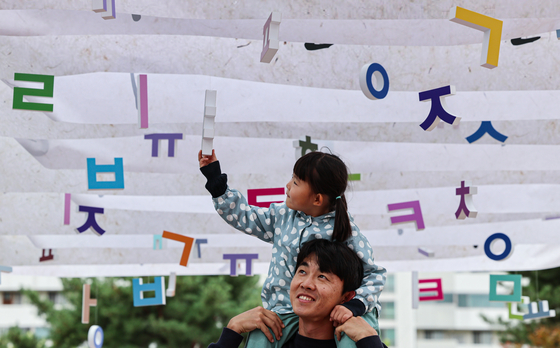A father and his daughter are observing the exhibits on display at the National Hangeul Museum in Yongsan District, central Seoul, in October of the previous year. [NEWS1]
The number of fathers who have exited the workforce to care for their children reached a record high last year at 16,000.
Based on the latest data from Statistics Korea, there was a 37.4 percent surge in economically inactive fathers dedicating themselves to parenting, rising from 12,000 in 2022.
This milestone in the previous year marked the highest count since the data was initially recorded in June 1999.
Over the span of a decade, the figure nearly tripled, escalating from 6,000 in 2013 to 9,000 in 2019.
The falling birth rate in the nation is a contributing factor to the rise of males as primary breadwinners.
While the overall number of individuals leaving the workforce to care for their children decreased from 1.42 million in 2013 to approximately 856,000 last year, the proportion of men committing to child-rearing duties showed a relative increase.
This trend reflects societal shifts that are promoting more men to take paternity leave, resulting in a growing number of husbands and fathers sharing the responsibilities of parenting.
Breaking down the demographics, fathers in their 40s accounted for more than half of the full-time fathers, with around 4,600 fathers in their 30s representing 28.8 percent.
In contrast, last year witnessed about 840,000 women becoming economically inactive for parenting, marking a 14.7 percent decrease from the previous year.
Over the course of a decade, the count of full-time mothers nearly halved. In 2013, approximately 1.47 million mothers stayed at home to care for their children. This number decreased to 1.26 million in 2017 and further dropped to about 984,000 in 2022.
Despite these changes, the number of full-time mothers significantly surpasses that of their male counterparts by almost 50 times, highlighting the continued heavy burden of parenting on women in Korea.
Mothers in their 30s constituted the largest age group, making up 59.1 percent of all economically inactive mothers, followed by non-working mothers in their 40s.
On the other hand, the economically active female population is on the rise.
In 2011, less than half—49.8 percent—of all women were part of the workforce. This ratio increased to 50.3 percent in 2013 and further to 53.5 percent in 2019.
The female working population ratio reached a record high of 55.6 percent last year.
According to data from the Organization for Economic Cooperation and Development (OECD), in 2022, Korea’s female labor force participation rates slightly fell below the OECD average of 56.4 percent, standing at 54.6 percent.
The Federation of Korean Industries also highlighted that the economic participation of Korean women ranked among the lowest of 37 OECD member states in 2021.
To enhance the country’s economic growth, the government is set to unveil initiatives this month aimed at boosting female economic activity.

